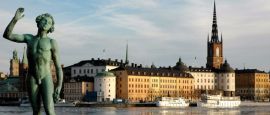Sweden Weather, climate and geography
Weather & climate
Despite its northerly latitude, Sweden has a relatively mild climate. Summer is generally from June until August, winter from November until March, but this can vary greatly depending on where you are. July temperatures average 13°C-17°C (55°F-62°F) with potential highs of 30°C (86°F) in the south. Winter temperatures are less consistent, going from -22°C to 0°C (-7.6°F- -32°F), but in the far north the temperature can drop down to -30°C (-22°F) or even lower.
Above the Arctic Circle you will see continuous daylight in the summer, and during the winter, the sun won’t rise – perfect for those who wish to see the Northern Lights. Southern Sweden averages 19 hours of daylight in the summer and 6 hours in the winter.
Precipitation is fairly high, with around 170 wet days a year in the capital Stockholm.
During the winter, thick layers are needed, with wind chill proving particularly problematic. Far north, stick to woollen layers closest to your skin, and avoid cotton socks. Sturdy footwear, scarves, hats and gloves will be required regardless of where you are.
During the summer, lighter clothing is all you need. Shorts or jeans and a t-shirt is standard attire, with a light jacket or sweater for the evenings. Cobblestones in the city, and unpaved roads in the countryside, means flat shoes or sandals are best for getting around.
Waterproof clothing is recommended year round.
Geography
With a land mass totalling around 449,964 sq km (173,732 sq miles), Sweden is the fifth largest country in Europe and the largest of the Scandinavian bloc. Sharing land borders with Norway to the west and Finland to the northeast, the country also has 3,218km (2,000 miles) of coastline, much of it on the Baltic Sea. What remains faces the Gulf of Bothnia – a chilly stretch of sea, shared with Finland. To the south, Denmark is another near neighbour and is directly linked to the southern Swedish port of Malmö via the Öresund Bridge. Along with Denmark, Sweden has maritime borders with Germany, Poland, Russia, Lithuania, Latvia and Estonia.
With a population of over 9 million, most of whom inhabit the cities and the south, the vast majority (78%) of Sweden’s enormous tracts of land are forested, while another 8% is covered in water. The largest lake is Vänern, with an area of 5,655 sq km (2,140 sq miles) and the highest peak is Kebnekaise, which stands 2,104m (6,903ft) above sea level and is part of the Scandinavian mountain chain on the Norwegian border. In the far north, Sweden’s portion of Lapland extends well into the Arctic Circle, with the northernmost outpost of Swedish civilisation to be found in the tiny Lappish town of Treriksröset on the three way border between Finland, Norway and Sweden. The country’s southernmost point is the small fishing village of Smygehuk on the Baltic coast, close to the tiny city of Trelleborg in Skåne County.
Do you have any Feedback about this page?
© 2025 Columbus Travel Media Ltd. All rights reserved. No part of this site may be reproduced without our written permission, click here for information on Columbus Content Solutions.




 You know where
You know where